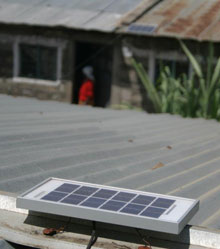
Advances are opening solar to the 1.3 billion people who don’t have access to grid electricity.
The falling cost of LED lighting, batteries, and solar panels, together with innovative business plans, are allowing millions of households in Africa and elsewhere to switch from crude kerosene lamps to cleaner and safer electric lighting. For many, this offers a means to charge their mobile phones, which are becoming ubiquitous in Africa, instead of having to rent a charger.
Technology advances are opening up a huge new market for solar power: the approximately 1.3 billion people around the world who don’t have access to grid electricity. Even though they are typically very poor, these people have to pay far more for lighting than people in rich countries because they use inefficient kerosene lamps. While in most parts of the world solar power typically costs far more than electricity from conventional power plants—especially when including battery costs—for some people, solar power makes economic sense because it costs half as much as lighting with kerosene.
Hundreds of companies are swooping in to grab a piece of this market.
“This sector has exploded,” says Richenda Van Leeuwen, senior director for the Energy and Climate team at the United Nations Foundation. “There’s been a sea change in the last five years.”
The sudden interest is fueled by the advent of relatively low-cost LEDs, she says. Not long ago, powering lightbulbs required a solar panel that could generate 20 to 30 watts, since only incandescent lightbulbs were affordable. LEDs are far more efficient. Now people can have bright lighting using a panel that only generates a couple of watts of power, Van Leeuwen says.
But such technological improvements aren’t quite enough to open up the market. High-quality LED systems, with a pair of lamps and enough battery storage for several hours of lighting, cost less than $50. The systems can pay for themselves in less than two years, but the upfront cost is still too steep for many people.
Eight19, a company based in Cambridge, U.K., is one of several companies offering some type of payment plan to make the systems affordable. Customers pay $10 for the solar lighting system, which includes a 2.5-watt solar panel, two LED overhead lamps, and a lithium-iron phosphate battery pack. Then they pay a weekly fee for the power it generates.
- Friday, January 27, 2012
- By Kevin Bullis
 Winning numbers: Customers enter a numerical code to access power for lights and a mobile phone charger.
Winning numbers: Customers enter a numerical code to access power for lights and a mobile phone charger.Eight19
Each week, users buy a scratch card for about $1 from a local vendor. It gives them a number that they text to Eight19 for verification. The company sends them a verification code that they enter into a keypad on the battery pack. The code electronically unlocks the device for a week, allowing the battery to supply power to the LEDs or to a phone charger.
Several other companies, including major telecoms, are trying variants on this pay-as-you-go approach. One thing that sets Eight19 apart is that after a customer has covered the cost of the device—typically in about 18 months—he or she can trade up for a bigger one with a larger solar panel, a bigger battery, and more lights, and the capacity to power a small radio. In this way, using only the money they would have been spending on kerosene or for renting phone chargers, they can gradually get to the point where they have enough power for, say, a refrigerator, or a money-making appliance such as a sewing machine, says Simon Bransfield-Garth, CEO of Eight19.
Eight19 has tested the system with several hundred customers, and it is starting a project to sell 4,000 systems in cooperation with the NGO Solar Aid, which will help with distribution.
But Eight19 is a relatively small player so far. More established companies such as D.light have sold over one million solar lighting systems. Bransfield-Garth sees a lot of room for growth. “The poorest people are paying disproportionately high prices for their needs,” he says. “Solar power works well in this market.”
(Source)

 Follow
Follow